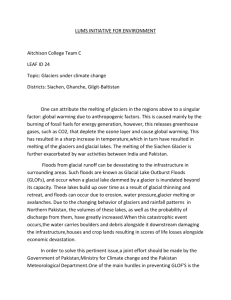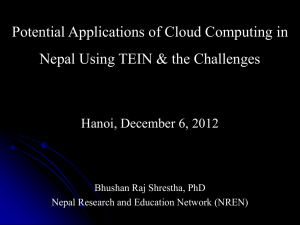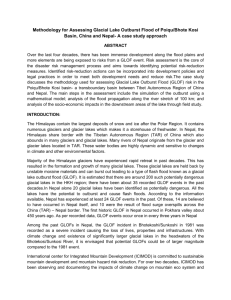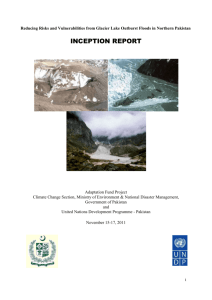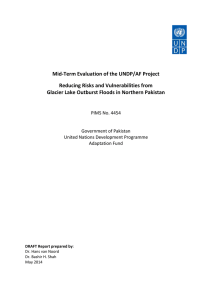Ministry of Science, Technology and Environment (MoSTE
advertisement
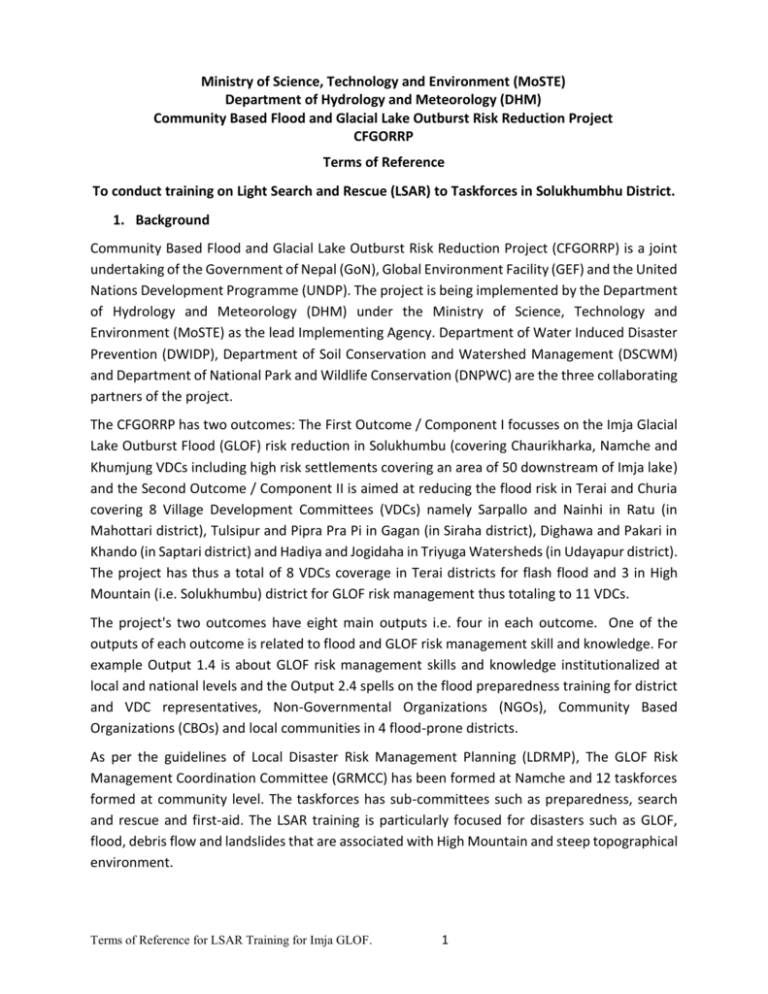
Ministry of Science, Technology and Environment (MoSTE) Department of Hydrology and Meteorology (DHM) Community Based Flood and Glacial Lake Outburst Risk Reduction Project CFGORRP Terms of Reference To conduct training on Light Search and Rescue (LSAR) to Taskforces in Solukhumbhu District. 1. Background Community Based Flood and Glacial Lake Outburst Risk Reduction Project (CFGORRP) is a joint undertaking of the Government of Nepal (GoN), Global Environment Facility (GEF) and the United Nations Development Programme (UNDP). The project is being implemented by the Department of Hydrology and Meteorology (DHM) under the Ministry of Science, Technology and Environment (MoSTE) as the lead Implementing Agency. Department of Water Induced Disaster Prevention (DWIDP), Department of Soil Conservation and Watershed Management (DSCWM) and Department of National Park and Wildlife Conservation (DNPWC) are the three collaborating partners of the project. The CFGORRP has two outcomes: The First Outcome / Component I focusses on the Imja Glacial Lake Outburst Flood (GLOF) risk reduction in Solukhumbu (covering Chaurikharka, Namche and Khumjung VDCs including high risk settlements covering an area of 50 downstream of Imja lake) and the Second Outcome / Component II is aimed at reducing the flood risk in Terai and Churia covering 8 Village Development Committees (VDCs) namely Sarpallo and Nainhi in Ratu (in Mahottari district), Tulsipur and Pipra Pra Pi in Gagan (in Siraha district), Dighawa and Pakari in Khando (in Saptari district) and Hadiya and Jogidaha in Triyuga Watersheds (in Udayapur district). The project has thus a total of 8 VDCs coverage in Terai districts for flash flood and 3 in High Mountain (i.e. Solukhumbu) district for GLOF risk management thus totaling to 11 VDCs. The project's two outcomes have eight main outputs i.e. four in each outcome. One of the outputs of each outcome is related to flood and GLOF risk management skill and knowledge. For example Output 1.4 is about GLOF risk management skills and knowledge institutionalized at local and national levels and the Output 2.4 spells on the flood preparedness training for district and VDC representatives, Non-Governmental Organizations (NGOs), Community Based Organizations (CBOs) and local communities in 4 flood-prone districts. As per the guidelines of Local Disaster Risk Management Planning (LDRMP), The GLOF Risk Management Coordination Committee (GRMCC) has been formed at Namche and 12 taskforces formed at community level. The taskforces has sub-committees such as preparedness, search and rescue and first-aid. The LSAR training is particularly focused for disasters such as GLOF, flood, debris flow and landslides that are associated with High Mountain and steep topographical environment. Terms of Reference for LSAR Training for Imja GLOF. 1 These institutions at local level plays vital role in the preparedness and early response for disaster risk management. Studies have shown that communities' strong preparedness level and early response mechanism can save up to 80% of potential human losses. In this connection, the project has plans to install hydrological and meteorological stations, GLOF sensing sensors, automatic GLOF warning sirens, community based early warning system (hand operated siren, mega phones, water level gauge), awareness raising through trainings and Information, Education and Communication (IEC) materials . The project has procured CBEWS and LSAR equipment for GLOF risk mitigation in Solukhumbu districts in order to lessen the loss of lives and properties due to GLOF, Landslide induced dam outburst flood (LDOF), flash flood, landslide hazards in Solukhumbu. The purpose of the training is to raise awareness on LSAR, capacity building on use of LSAR, CBEWS equipment and first-aid kits. These trainings is expected to rescue the greatest number of people in the shortest duration of time as 80% of the injured or trapped victims have chance of survival if rescued in the first 24 hours after a disaster. CFGORRP, therefore intends to conduct LSAR training for GLOF, LDOF, flash-flood and landslide related disasters as a preparedness to GLOF risk reduction from Imja Lake for which this Terms of Reference (ToR) is referring to. 2. Objectives of the Assignment The main objective of the assignment is to conduct LSAR Training to 12 task forces formed for preparedness and responses to GLOF and Landslide disasters within GLOF impact zones of 50 km. from Imja Lake. Specific objectives of the assignment are: To design and develop most appropriate theoretical and practical sessions of LSAR Training module. To conduct LSAR trainings to 12 taskforce members from Solukhumbu Districts. Refine the training resource materials and session plans after receiving feedback and evaluating the training programs for further use. 3. Target Audiences The target audiences are members of 12 Taskforces comprising of 11 members (male/ female) divided into sub-groups such as early warning (preparedness), search and rescue and first-aid members, GLOF risk management coordination committee and staff of Sagarmatha National Park. These taskforce members will be trained for using LSAR equipment during GLOF events and respond to automatic GLOF sirens and generate warnings to local community through community based early warning equipment (hand-held sirens, megaphones and water level gauge etc.) and use of first-aid kits. Terms of Reference for LSAR Training for Imja GLOF. 2 4. Training Venue: The training has to be conducted in three locations Namche, Phakding and Lukla or other appropriate locations convenient for local participants as agreed by CFGORRP /DHM & SNP. 5. Scope of Works The scope of works include inter-alia, but not limited to the followings: Provide information on strategic intervention actions of CFGORRP /DHM on Imja Lake lowering, lake monitoring, CBEWS and institutional mechanisms for Imja GLOF risk reduction. Provide basic information on GLOF warning system (automatic sirens, handheld sirens, megaphones, water level gauges etc.), information on First Aid Kit and its general usages, and disaster response mechanism. Also provide basic information on roles and responsibilities of Task forces (for sub-groups such as early warning (preparedness), search and rescue and first-aid) for coordinated search and rescue operations. Collect, collate, appraise and refine all relevant data and information related to LSAR training on flood, GLOF and landslides from the Armed Police Force (APF), Nepal Police, Nepal Army and other organizations and individuals etc. if any. Collect, study and review standard LSAR curriculum and practical sessions (exercises) developed by different national and international organizations such as the International Search and Rescue Advisory Group (INSARAG), Federal Emergency Management Agency (FEMA), etc. Based on the collected and compiled resource materials, develop 3 - 4 day GLOF, LDOF, flash flood and landslides disaster specific session plans with detailed methodology of delivering each training session. Provide adequate practical sessions and include relevant resource materials, exercise sheets, brainstorming, simulation, and practical exercise, audio/video clips etc. to make the sessions participants' focused, interactive and informative. Obtain approval from CFGORRP/DHM on the session plan and resources for search and rescue materials. While developing the resource material and session plan for conducting the training focus on following main themes: o GLOF warning system and mechanism: General description of hydrometeorological sensors, automatic GLOF warning sirens and community based early warning system (handheld sirens, mega phones and water level gauges (normal flow & danger level) and responses mechanism of taskforce members. Provide guidelines for collecting water levels at regular intervals, recording data Terms of Reference for LSAR Training for Imja GLOF. 3 and sharing information with community members, SNP, CFGORRP / DHM. In case of water level at danger levels provide training on mechanism of responses of taskforces. o Guidelines for responses of automatic GLOF warnings and use of CBEWS to warn local community. o General guidelines for operation of evacuation centers and roles and responsibilities of taskforces. o General uses of first aid equipment and medicines. o Search and rescue planning: Assessing GLOF, LDOF, debris flow, flash flood and landslides and appropriately plan personnel, equipment and tools for search and rescue,. ). o Teaming up for GLOF, LDOF, debris flow, flash flood and landslide for search and rescue. Preparation of seven steps rescue operations: Gather Facts; Assess Damage to infrastructure; Identify Resources; Prioritize Rescue operations with due emphasis on vulnerable, women and children, disabled, elders etc.; Develop a Rescue Plan; Conduct the search and Rescue operation; and Evaluate the Progress. o Adoption of systematic search and rescue techniques for GLOF, LDOF, flash flood, debris flow and landslide victims. o Following safe rescue techniques (locating, lifting, leveraging, cribbing and removal of victims). o Adoption of rescuer safety first principles during search and rescue operations (triaging or stabilizing victims) and follow safety measures in Removing Victims etc. Conduct the training in Nepali language for 15-20 participants in close coordination with STA, GSI Specialist etc. The training should include a theoretical background and comprehensive practical and exercise sessions. Undertake pre- and post-training evaluation to assess the increase in knowledge of participants on LSAR, CBEWS and first-aid. Evaluate the overall training program (training materials, effectiveness of the training, etc.) to readjust, realign and revise the training materials if any. Based on the experience gained and lessons learnt while conducting the trainings, revise the training materials as per local needs, constraints and circumstances. Prepare and submit training completion report with methodology and resource materials, participants number (male female), relevant photograph/video, lesson learnt etc. Make a presentation at PMU after conducting all trainings and revision of all training materials. Terms of Reference for LSAR Training for Imja GLOF. 4 6. Guidance and Supervision The service provider shall work under the guidance and supervision of the National Project Director (NPD) and National Project Manager (NPM) and in close coordination with Senior Technical Advisor and Gender and Social Inclusion (GSI) Specialist. The context of LSAR trainings shall be focused for GLOF, LDOF, debris flow, flash flood and landslide in mountainous area with steep slopes in Solukhumbu District. PMU will be responsible for overall training management and other logistic supports, Sagarmatha National Parks (SNP) and GLOF Risk Management Coordination Committee (GRMCC) shall coordinate training venue and field practical exercise. 7. Assignment Duration The duration of this assignment is of 4 weeks for the complete package including material development, travel, conducting trainings and submission of final training completion report. 8. Required Human Resources, Qualification and Experiences Following human resources are required for the assignment. Lead Trainer Bachelor degree in any disciplines having ToT training on LSAR/Search and Rescue (SAR) and with at least 5 years' of experience of conducting LSAR Training in Nepal. Trainers Knowledge in providing SAR Trainings. Preferences will be given to knowledge on GLOF, Flood, debris flow, Landslide, disaster management and knowledge on uses of first aid kits etc. Bachelor degree in any disciplines having ToT Knowledge in providing SAR Trainings on LSAR and with at least 3 years' of Trainings. Preferences will be given to knowledge on experience of conducting LSAR Training in Nepal. GLOF, Flood, debris flow, Landslide, disaster management and knowledge on uses of first aid kits etc. 9. Deliverables The contract will be deliverable–based and payment will be made upon submission and acceptance of the deliverables: a). Submission and acceptance of training materials, Terms of Reference for LSAR Training for Imja GLOF. 5 b). Successful completion of training program and c). Submission and acceptance of Training completion report. Please note that cost associated with logistics such as distribution of training materials to participants, training hall charges, participants' other expenses will be borne by the project. An original copy of theoretical components of training materials is to be provided by the consultant for reproduction at least 5 days prior to the training. However, the consultants need to bear cost associated with the resource person fee, travel, equipment for the practical sessions, simulation models and other associated cost including fooding and accomodation. 10. Mode of Payment The service provider shall be paid in three installments: First Installment: 50% of the contract amount shall be paid upon signing of the contract and submission and acceptance of training materials. Second Installment: 30% of the contract amount shall be paid upon successful completion of training programs. Third Installment: 20% of the contract amount shall be paid upon submission and acceptance of training completion report. Terms of Reference for LSAR Training for Imja GLOF. 6
